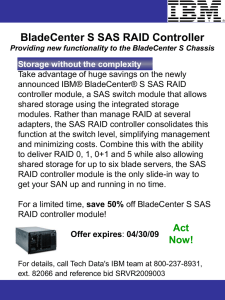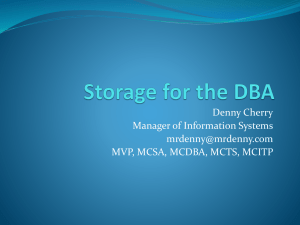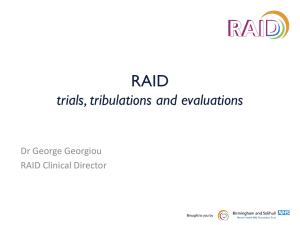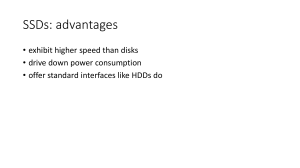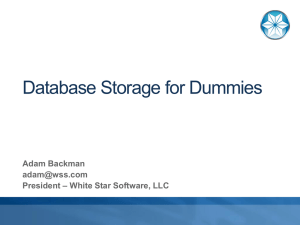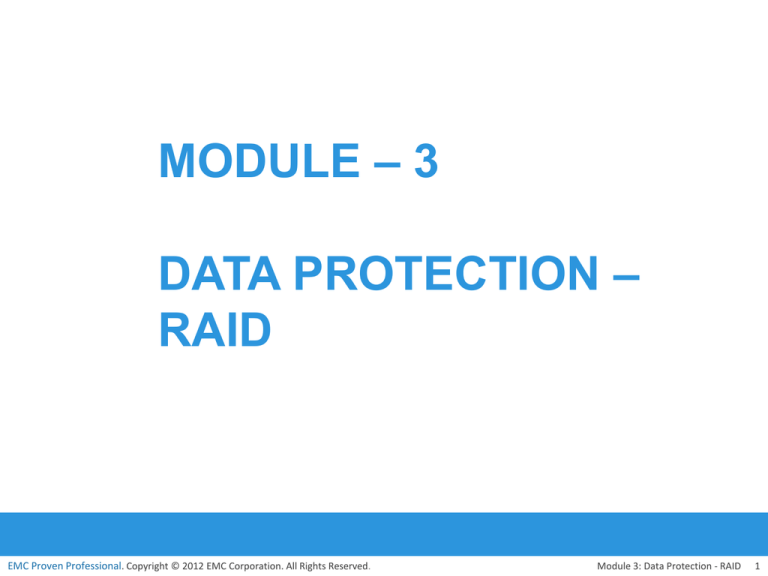
MODULE – 3
DATA PROTECTION –
RAID
EMC Proven Professional. Copyright © 2012 EMC Corporation. All Rights Reserved.
Module 3: Data Protection - RAID
1
Module 3: Data Protection – RAID
Upon completion of this module, you should be able to:
• Describe RAID implementation methods
• Describe the three RAID techniques
• Describe commonly used RAID levels
• Describe the impact of RAID on performance
• Compare RAID levels based on their cost, performance, and
protection
EMC Proven Professional. Copyright © 2012 EMC Corporation. All Rights Reserved.
Module 3: Data Protection - RAID
2
Module 3: Data Protection – RAID
Lesson 1: RAID Overview
During this lesson the following topics are covered:
• RAID Implementation methods
• RAID array components
• RAID techniques
EMC Proven Professional. Copyright © 2012 EMC Corporation. All Rights Reserved.
Module 3: Data Protection - RAID
3
Why RAID?
RAID
It is a technique that combines multiple disk drives into a logical unit (RAID
set) and provides protection, performance, or both.
• Due to mechanical components in a disk drive it offers limited
•
performance
An individual drive has a certain life expectancy and is measured
in MTBF:
For example: If the MTBF of a drive is 750,000 hours, and there are
1000 drives in the array, then the MTBF of the array is 750 hours
(750,000/1000)
• RAID was introduced to mitigate these problems
EMC Proven Professional. Copyright © 2012 EMC Corporation. All Rights Reserved.
Module 3: Data Protection - RAID
4
RAID Implementation Methods
• Software RAID implementation
Uses host-based software to provide RAID functionality
Limitations
Use host CPU cycles to perform RAID calculations, hence impact
overall system performance
Support limited RAID levels
RAID software and OS can be upgraded only if they are compatible
• Hardware RAID Implementation
Uses a specialized hardware controller installed either on a host or
on an array
EMC Proven Professional. Copyright © 2012 EMC Corporation. All Rights Reserved.
Module 3: Data Protection - RAID
5
RAID Array Components
Logical Array
(RAID Sets)
RAID
Controller
Hard Disks
Host
RAID Array
EMC Proven Professional. Copyright © 2012 EMC Corporation. All Rights Reserved.
Module 3: Data Protection - RAID
6
RAID Techniques
• Three key techniques used for RAID are:
Striping
Mirroring
Parity
EMC Proven Professional. Copyright © 2012 EMC Corporation. All Rights Reserved.
Module 3: Data Protection - RAID
7
RAID Technique – Striping
Strip
RAID
Controller
Stripe
Host
EMC Proven Professional. Copyright © 2012 EMC Corporation. All Rights Reserved.
Module 3: Data Protection - RAID
8
RAID Technique – Mirroring
Block 0
Block 0
RAID
Controller
Block 0
Host
EMC Proven Professional. Copyright © 2012 EMC Corporation. All Rights Reserved.
Module 3: Data Protection - RAID
9
RAID Technique – Parity
4
D1
6
D2
RAID
Controller
1
D3
7
Host
D4
18
P
Actual parity calculation is a bitwise XOR operation
EMC Proven Professional. Copyright © 2012 EMC Corporation. All Rights Reserved.
Module 3: Data Protection - RAID 10
Data Recovery in Parity Technique
4
D1
6
D2
RAID
Controller
?
D3
7
Host
D4
Regeneration of data when Drive D3 fails:
4 + 6 + ? + 7 = 18
? = 18 – 4 – 6 – 7
?=1
EMC Proven Professional. Copyright © 2012 EMC Corporation. All Rights Reserved.
18
P
Module 3: Data Protection - RAID 11
Module 3: Data Protection – RAID
Lesson 2: RAID Levels
During this lesson the following topics are covered:
• Commonly used RAID levels
• RAID impacts on performance
• RAID comparison
• Hot spare
EMC Proven Professional. Copyright © 2012 EMC Corporation. All Rights Reserved.
Module 3: Data Protection - RAID 12
RAID Levels
• Commonly used RAID levels are:
RAID 0 – Striped set with no fault tolerance
RAID 1 – Disk mirroring
RAID 1 + 0 – Nested RAID
RAID 3 – Striped set with parallel access and dedicated parity disk
RAID 5 – Striped set with independent disk access and a
distributed parity
RAID 6 – Striped set with independent disk access and dual
distributed parity
EMC Proven Professional. Copyright © 2012 EMC Corporation. All Rights Reserved.
Module 3: Data Protection - RAID 13
RAID 0
C
B
A
Data from host
RAID Controller
A1
B1
C1
A2
B2
C2
A3
B3
C3
A4
B4
C4
A5
B5
C5
Data Disks
EMC Proven Professional. Copyright © 2012 EMC Corporation. All Rights Reserved.
Module 3: Data Protection - RAID 14
RAID 1
F
E
D
C
B
A
Data from host
RAID Controller
A
B
C
A
B
C
Mirror Set
EMC Proven Professional. Copyright © 2012 EMC Corporation. All Rights Reserved.
D
E
F
D
E
F
Mirror Set
Module 3: Data Protection - RAID 15
Nested RAID – 1+0
C
B
A
Data from host
Striping
RAID Controller
Mirroring
A1
B1
C1
Mirror Set A
A1
B1
C1
Mirroring
A2
B2
C2
Mirror Set B
EMC Proven Professional. Copyright © 2012 EMC Corporation. All Rights Reserved.
Mirroring
A2
B2
C2
A3
B3
C3
A3
B3
C3
Mirror Set C
Module 3: Data Protection - RAID 16
RAID 3
C
B
A
Data from host
RAID Controller
A1
B1
C1
A2
B2
C2
Data Disks
EMC Proven Professional. Copyright © 2012 EMC Corporation. All Rights Reserved.
A3
B3
C3
A4
B4
C4
AP
BP
CP
Dedicated Parity Disk
Module 3: Data Protection - RAID 17
RAID 5
C
B
A
Data from host
RAID Controller
A1
B1
C1
A2
B2
C2
A3
B3
CP
A4
BP
C3
AP
B4
C4
Distributed Parity
EMC Proven Professional. Copyright © 2012 EMC Corporation. All Rights Reserved.
Module 3: Data Protection - RAID 18
RAID 6
C
B
A
Data from host
RAID Controller
A1
B1
C1
A2
B2
CP
A3
BP
CQ
AP
BQ
C2
AQ
B3
C3
Dual Distributed Parity
EMC Proven Professional. Copyright © 2012 EMC Corporation. All Rights Reserved.
Module 3: Data Protection - RAID 19
RAID Impacts on Performance
RAID Controller
Cp new
Cp old
=
-
C4 old
+
C4 new
2
3
4
A1
B1
C1
1
A2
B2
C2
A3
B3
CP
A4
BP
C3
AP
B4
C4
• In RAID 5, every write (update) to a disk manifests as four I/O
•
•
operations (2 disk reads and 2 disk writes)
In RAID 6, every write (update) to a disk manifests as six I/O operations
(3 disk reads and 3 disk writes)
In RAID 1, every write manifests as two I/O operations (2 disk writes)
EMC Proven Professional. Copyright © 2012 EMC Corporation. All Rights Reserved.
Module 3: Data Protection - RAID 20
RAID Penalty Calculation Example
• Total IOPS at peak workload is 1200
• Read/Write ratio 2:1
• Calculate disk load at peak activity for:
RAID 1/0
RAID 5
EMC Proven Professional. Copyright © 2012 EMC Corporation. All Rights Reserved.
Module 3: Data Protection - RAID 21
Solution: RAID Penalty
• For RAID 1/0, the disk load (read + write)
= (1200 x 2/3) + (1200 x (1/3) x 2)
= 800 + 800
= 1600 IOPS
• For RAID 5, the disk load (read + write)
= (1200 x 2/3) + (1200 x (1/3) x 4)
= 800 + 1600
= 2400 IOPS
EMC Proven Professional. Copyright © 2012 EMC Corporation. All Rights Reserved.
Module 3: Data Protection - RAID 22
RAID Comparison
RAI
D
leve
l
Min
disk
s
Available
storage
capacity (%)
Read
performance
Write
performance
Write
penalty
Mirror
Mirror
Protection
1
2
50
Better than
single disk
Slower than single
disk, because every
write must be
Moderate
committed to all
disks
1+0
4
50
Good
Good
Fair for random
reads and good
for sequential
reads
Good for
random and
sequential reads
Poor to fair for
small random writes
High
fair for large,
sequential writes
Parity
(Supports single
disk failure)
Fair for random and
High
sequential writes
Parity
(Supports single
disk failure)
3
5
6
3
3
4
[(n-1)/n]*100
[(n-1)/n]*100
[(n-2)/n]*100
where n = number of disks
Good for
Poor to fair for
random and
random and
sequential reads sequential writes
EMC Proven Professional. Copyright © 2012 EMC Corporation. All Rights Reserved.
Moderate
Very High
Parity
(Supports two
disk failures)
Module 3: Data Protection - RAID 23
Suitable RAID Levels for Different Applications
• RAID 1+0
Suitable for applications with small, random, and write intensive
(writes typically greater than 30%) I/O profile
Example: OLTP, RDBMS – Temp space
• RAID 3
Large, sequential read and write
Example: data backup and multimedia streaming
• RAID 5 and 6
Small, random workload (writes typically less than 30%)
Example: email, RDBMS – Data entry
EMC Proven Professional. Copyright © 2012 EMC Corporation. All Rights Reserved.
Module 3: Data Protection - RAID 24
Hot Spare
Failed disk
RAID
Controller
Replace
failed disk
Hot spare
EMC Proven Professional. Copyright © 2012 EMC Corporation. All Rights Reserved.
Module 3: Data Protection - RAID 25
Module 3: Summary
Key points covered in this module:
• RAID implementation methods and techniques
• Common RAID levels
• RAID write penalty
• Compare RAID levels based on their cost and performance
EMC Proven Professional. Copyright © 2012 EMC Corporation. All Rights Reserved.
Module 3: Data Protection - RAID 26
Exercise 1: RAID
• A company is planning to reconfigure storage for their
accounting application for high availability
Current configuration and challenges
Application performs 15% random writes and 85% random reads
Currently deployed with five disk RAID 0 configuration
Each disk has an advertised formatted capacity of 200 GB
Total size of accounting application’s data is 730 GB which is unlikely
to change over 6 months
Approaching end of financial year, buying even one disk is not
possible
• Task
Recommend a RAID level that the company can use to restructure
their environment fulfilling their needs
Justify your choice based on cost, performance, and availability
EMC Proven Professional. Copyright © 2012 EMC Corporation. All Rights Reserved.
Module 3: Data Protection - RAID 27
Exercise 2: RAID
• A company (same as discussed in exercise 1) is now planning to
reconfigure storage for their database application for HA
Current configuration and challenges
The application performs 40% writes and 60% reads
Currently deployed on six disk RAID 0 configuration with advertised
capacity of each disk being 200 GB
Size of the database is 900 GB and amount of data is likely to change
by 30% over the next 6 months
It is a new financial year and the company has an increased budget
• Task
Recommend a suitable RAID level to fulfill company’s needs
Estimate the cost of the new solution (200GB disk costs $1000)
Justify your choice based on cost, performance, and availability
EMC Proven Professional. Copyright © 2012 EMC Corporation. All Rights Reserved.
Module 3: Data Protection - RAID 28

